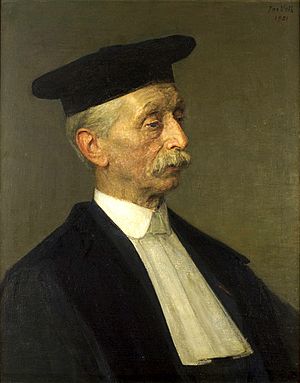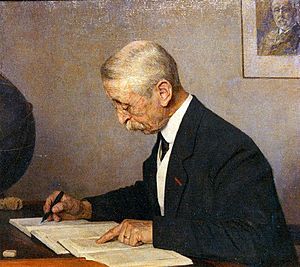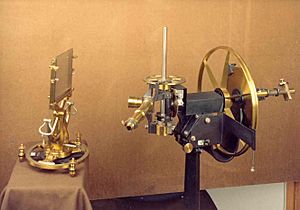Jacobus Kapteyn facts for kids
Quick facts for kids
Jacobus Cornelius Kapteyn
|
|
|---|---|

Jacobus Kapteyn. Painting by Jan Veth (1921).
|
|
| Born | 19 January 1851 Barneveld
|
| Died | 18 June 1922 (aged 71) |
| Nationality | Dutch |
| Alma mater | University of Utrecht |
| Known for | Star streaming Discovery of evidence for galactic rotation Kapteyn's star Parallactic instrument of Kapteyn Kapteyn Universe |
| Awards | Bruce Medal (1913) James Craig Watson Medal (1913) Gold Medal of the Royal Astronomical Society (1902) |
| Scientific career | |
| Fields | Astronomy |
| Institutions | University of Groningen |
| Doctoral students | Willem de Sitter, Pieter Johannes van Rhijn, Willem Schouten, Jan Oort |

Prof Jacobus Cornelius Kapteyn (born January 19, 1851 – died June 18, 1922) was a famous Dutch astronomer. He spent many years studying the Milky Way galaxy. He was the first to find clues that our galaxy is actually spinning. Kapteyn also suggested that there might be dark matter in space. He thought this because of how stars were moving, back in 1922.
Contents
Kapteyn's Early Life and Family
Jacobus Kapteyn was born in Barneveld, a town in the Netherlands. His parents were Gerrit J. and Elisabeth C. Kapteyn. He was one of 15 children in his family. Many of his family members were very good at mathematics and physics.
Jacobus passed his university entrance exams when he was just 16 years old. But his parents wanted him to wait one more year. In 1868, he started studying mathematics and physics at the University of Utrecht. He did very well in his studies. When he graduated, he earned his degree with great honors. This strong start helped him a lot in his future career.
Kapteyn was a very caring father to his children. This was quite unusual for fathers in the 1880s. His two daughters, Jacoba Cornelia and Henrietta, and his son, Gerrit, all went to a boys' school. Later, his daughters did something very important for women. They went to university to study law and medicine. His daughter Henrietta (1881–1956) later married another astronomer, Ejnar Hertzsprung. They had a granddaughter named Rigel.
Kapteyn's Career in Astronomy
In 1875, after finishing his big research project, Kapteyn worked for three years. He worked at the Leiden Observatory. In 1878, he became the first professor of astronomy. He also taught theoretical mechanics at the University of Groningen.
At Groningen, he started the Astronomical Laboratory in 1896. He then became the director of this new facility. Kapteyn worked as both a professor and director at Groningen until he retired in 1921. In 1888, he became a member of the Royal Netherlands Academy of Arts and Sciences.
Mapping the Southern Stars
From 1896 to 1900, Kapteyn did not have his own observatory. So, he offered to help David Gill. Gill was taking special photos of stars in the Southern Hemisphere. He was working at the Royal Observatory at the Cape of Good Hope.
To measure these star photos, Kapteyn used a special tool. It was called a parallactic instrument, which he built himself. Their teamwork led to a huge book called Cape Photographic Durchmusterung. This book listed the positions and brightness of 454,875 stars in the Southern Hemisphere.
In 1897, while working on this project, he found Kapteyn's Star. This star moved across the sky faster than any other known star at that time. It held this record until Barnard's Star was found in 1916.
Discovering Star Movement
In 1904, Kapteyn was studying how stars move. He noticed that their movements were not random, as people thought back then. He found that stars seemed to move in two main "streams." These streams were going in almost opposite directions.
Later, scientists realized that Kapteyn's findings were the first clue. They showed that our own galaxy is actually spinning. This discovery eventually led to the idea of galactic rotation. Astronomers Bertil Lindblad and Jan Oort later confirmed this.
In 1906, Kapteyn started a big plan. He wanted to study how stars are spread out in our galaxy. His plan was to count stars in 206 different areas of the sky. For each star, he wanted to measure its brightness, type, speed, and movement. This huge project was the first time astronomers worked together on such a large scale. Over forty different observatories helped him.
Around 1913, Kapteyn developed a theory about how stars are formed. He based this on his observations of cloudy areas in space called nebulae. He thought that stars in these irregular nebulae eventually turned into planetary nebulae. While his theory wasn't completely right, it did have some good ideas.
Later Career and Retirement
Kapteyn received the James Craig Watson Medal in 1913. In 1920, he took a part-time job at the University of Leiden. This allowed him to be closer to his daughter Henrietta and his granddaughter Rigel. In his later years, Kapteyn worked on combining all his life's research. He was revising and editing his ideas about the "Kapteyn Universe."
Kapteyn retired in 1921 when he was seventy years old. However, his former student, Willem de Sitter, asked for his help. De Sitter was the director of the Leiden Observatory. He wanted Kapteyn to help update the observatory to modern standards.
Today, the astronomy institute at the University of Groningen is named after Kapteyn. A street in Groningen city is also named J.C. Kapteynlaan. Also, the Jacobus Kapteyn Telescope (JKT) on La Palma in the Canary Islands is named in his honor.
The Kapteyn Universe Model
Many astronomers in Kapteyn's time were very interested in the size and structure of our galaxy. Around 1900, an astronomer named Hugo von Seeliger tried to figure out the galaxy's shape. He did this by counting stars of different brightness levels. He found out how quickly the galaxy seemed to get smaller in different parts of the sky.
In 1901, Kapteyn used a method based on star movements. He used statistics to estimate the average distance to stars of different brightness. This helped him figure out the true scale of von Seeliger's findings. Together, von Seeliger and Kapteyn concluded that our galaxy was a flattened, disc-shaped system. They estimated it was about 10,000 light-years wide and 2,000 light-years thick. They also thought the Sun was fairly close to the center, about 600 light-years away. Kapteyn confirmed these results using star counts. He called his findings his first model of the galaxy.
Challenges to the Model
Even though Kapteyn made great progress, there was one big problem. His work was based on an idea that wasn't proven: that light does not get absorbed in space. If light *was* absorbed, then stars would look fainter. This would make them seem farther away than they really are. Light absorption would also make the galaxy appear to spread out faster than it actually does. If light absorption turned out to be important, Kapteyn's conclusions would be wrong.
To solve this, Kapteyn spent years studying and measuring how much light was absorbed. In 1917, people started debating Kapteyn's ideas about interstellar absorption. The main argument was about a "zone of avoidance" where fewer stars were seen. By 1918, Kapteyn was sure that light absorption was very small. He confidently stood by his first model for the galaxy's structure.
Kapteyn shared his findings in his life's main work. It was called First Attempt at a Theory of the Arrangement and Motion of the Sidereal System. This book was published in 1922. Other astronomers, like Anton Pannekoek and Harlow Shapley, questioned Kapteyn's model and distance scale. But Kapteyn was too unwell to meet with them and discuss his work. He passed away in June 1922, shortly after his book was published.
It was only after Kapteyn's death that Robert Trumpler discovered something important. He found that the amount of interstellar reddening (light absorption and scattering) was much greater than thought. This new discovery meant the galaxy was about 2.5 times larger than Kapteyn had estimated. It also showed that our Sun is much farther from the Galactic Center, about 9,200 light-years away.
Honours and Legacy
Awards
- Gold Medal of the Royal Astronomical Society (1902)
- James Craig Watson Medal (1913)
- Bruce Medal (1913)
Named After Him
- Kapteyn (crater) on the Moon
- Asteroid 818 Kapteynia
- Kapteyn's Star
- Kapteyn Astronomical Institute at the University of Groningen
- Jacobus Kapteyn Telescope (JKT) at La Palma, one of the Canary islands
- Kapteyn Package, an astronomy software package for Python
Images for kids
-
Kapteyn at the Fourth Conference International Union for Cooperation in Solar Research at Mount Wilson Observatory, 1910
See also
 In Spanish: Jacobus Kapteyn para niños
In Spanish: Jacobus Kapteyn para niños


